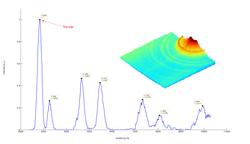Overview of the REGAE accelerator.
REGAE
Time resolved diffraction with relativistic electrons
Time resolved diffraction with relativistic electrons
Time resolved diffraction with relativistic electrons
REGAE the Relativistic Electron Gun for Atomic Exploration is a small electron accelerator build and operated within the framework of the Center for Free-Electron Laser Science CFEL [1].
REGAE provides high quality electron bunches for time resolved diffraction experiments and serves as test bed for accelerator R&D.
The Facility
REGAE employs a photo cathode RF gun operated at 3 GHz (S-Band) for the production of electrons. The 1½ cell gun cavity, a scaled version of the cavity in operation at the FLASH FEL, accelerates the electrons to energies of up to 5 MeV. A second RF cavity is operated in bunching mode, i.e. the electrons pass the cavity at the zero crossing of the field, such that a correlated energy spread is introduced. In the following drift section the bunch length decreases due to the different velocities and reaches a minimum about 4 m downstream of the bunching cavity where the target chamber is located. Extraordinary emittance requirements in the nm range (normalized) and pulse lengths down to a level of ~10 fs require operation at low bunch charges on the sub-pC scale.
Scientific program
Femtosecond Electron Diffraction (FED) has the potential to directly observe the most venerable concepts in chemistry and biology most notably enabling a direct atomic level view of transition states. The relevant motions for this barrier-crossing event occur on the sub-hundred femtosecond time-scale which is addressed by pump-probe type experiments. The advantage of relativistic electron diffraction as compared to the more common diffraction with electron energies in the 100 keV range are reduced space charge effects and the higher penetration depth of the electrons.
Example diffraction pattern recorded at REGAE with a 4.5MeV electron beam on a polycrystalline Gold target foil of 50 nm thickness.
Accelerator R&D concentrates on topics related to the challenging beam parameter requirements for diffraction experiments as beam dynamics, diagnostics of low charge beams and synchronization issues.

